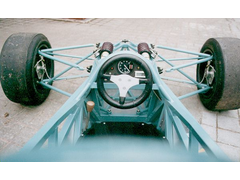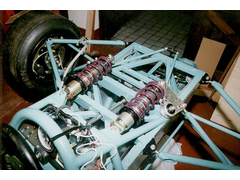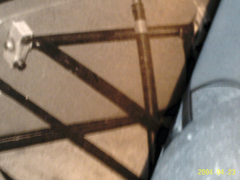Picture shows alloy billet brakets on front suspension utilising rod end bearings on wishbones - jcduroc - hope this is clear


Rescued attachment maren1pe.jpg

Posted at request.
Picture shows alloy billet brakets on front suspension utilising rod end bearings on wishbones - jcduroc - hope this is clear


Rescued attachment maren1pe.jpg
Another photo


Rescued attachment maren1pg.jpg
don't know the original question, but an alternative..

jcduroc has asked how the alloy brakets work:
" But can you describe (draft) the way it works? How does it accounts for fore and after and torsional loads? How are the bushes mounted?
Certainly the steel wishbones are not rotating "against" the alu blocks?
Can you catch my doubts? "
.........feel free to contribute guys's
Not quite sure what the question is - but the way things appear to be in the photos is that the suspension wishbones are rose jointed - not bushed -
hence the way the bolts go through the chassis joint makes them look like they're designed to move forward-reverse, rather than up-down. The
other point is that the ali triangles are just bellcranks - which transfer the in-out movement of the struts to forward reverse (or up-down) on the
dampers
HTH Steve
in race cars the stresses on the joints are under acceleration and braking, hence the rose joints are orientated the way they are so the bearings
can't 'pop out' under huge braking loads for example. suspension is normally stiff and with little movement so the bearing can easily
deal with it in this orientation.
ned.
ps probably completely irrelevant!
Very concise Ned. Not sure if I'm missing something in the question?
Hi Rob at al
The original question was:
In "Competition Car Suspension", pages 214-215 (Cover pages of Chap.9) the photo shows a real triangle upper wishbone supported by which
I imagine are alu blocks. In "Race and Rally Car Source Book" you can see (page 220) the same thing (same car, I guess) in Ian Scott's
car.
As Ned (correctly) states "in race cars the stresses on the joints are under acceleration and braking, hence the rose joints are orientated the
way they are so the bearings can't 'pop out' under huge braking loads". But here we are not talking about rose joints but
"bolt-ended" wishbone traingles.
So, in the case pictured in the attachement, considering that you should not have rotating, moment or fore and after loads against the alu blocks, how
should the bushes (which? mounted how?) deal with the extremities of the wishbone triangles?
Joćo
D... pic, next msg.
[Edited on 15/10/04 by jcduroc]
P.S.: Config also used in F1, pe, Brabham BT49D.
[Edited on 15/10/04 by jcduroc]
Hi Rob at al
The original question was:
In "Competition Car Suspension", pages 214-215 (Cover pages of Chap.9) the photo shows a real triangle upper wishbone supported by which
I imagine are alu blocks. In "Race and Rally Car Source Book" you can see (page 220) the same thing (same car, I guess) in Ian Scott's
car.
As Ned (correctly) states "in race cars the stresses on the joints are under acceleration and braking, hence the rose joints are orientated the
way they are so the bearings can't 'pop out' under huge braking loads". But here we are not talking about rose joints but
"bolt-ended" wishbone traingles.
So, in the case pictured in the attachement, considering that you should not have rotating, moment or fore and after loads against the alu blocks, how
should the bushes (which? mounted how?) deal with the extremities of the wishbone triangles?
Joćo
[Edited on 15/10/04 by jcduroc]


Rescued attachment Img_00761.jpg
Hi Terrapin,
You should put the bolts in round the other way by the looks of things on the forward leg of the top wishbones.
Bolts on cars should always point to the ground (ask Damon Hill). If the nuts fall off then the bolts dont drop out because gravity holds them in.
Williams forgot this practice at Silverstone one year, and Damon paid the price, during the warming up lap for a qualifying run, the bolts dropped
out, and the wishbones fell off!
Kind regards,
Darren
Not my car Darren, just an example from my photo archives - you are very correct though. Well spotted!
I always thought the alloy blocks incorporated bearings?
I'll see if I can catch Allan to ask him
You have to remember that this is some 30 years ago also!
[Edited on 18/10/04 by Terrapin_racing]
quote:
Originally posted by Terrapin_racing
I always thought the alloy blocks incorporated bearings?
I'll see if I can catch Allan to ask him
You have to remember that this is some 30 years ago also!